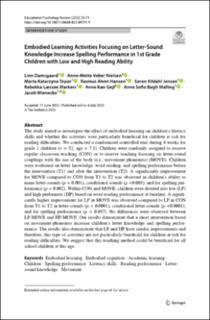Embodied learning activities focusing on letter-sound knowledge increase spelling performance in 1st grade children with low and high reading ability
Damsgaard, Linn; Nielsen, Anne-Mette Veber; Topor, Marta Katarzyna; Hansen, Rasmus Ahmt; Jensen, Søren Kildahl; Markers, Rebekka Læssøe; Gejl, Anne Kær; Malling, Anne Sofie Bøgh; Wienecke, Jacob
Peer reviewed, Journal article
Published version
Permanent lenke
https://hdl.handle.net/11250/3098237Utgivelsesdato
2023Metadata
Vis full innførselSamlinger
- Artikler / Articles [2119]
- Publikasjoner fra Cristin [1107]
Sammendrag
The study aimed to investigate the effect of embodied learning on children’s literacy skills and whether the activities were particularly beneficial for children at risk for reading difficulties. We conducted a randomized controlled trial during 4 weeks for grade 1 children (n = 52, age = 7.1). Children were randomly assigned to receive regular classroom teaching (CON) or to receive teaching focusing on letter-sound couplings with the use of the body (i.e., movement-phonemes) (MOVE). Children were evaluated on letter knowledge, word reading, and spelling performance before the intervention (T1) and after the intervention (T2). A significantly improvement for MOVE compared to CON from T1 to T2 was observed in children’s ability to name letter-sounds (p < 0.001), conditional sounds (p <0.001), and for spelling performance (p = 0.002). Within CON and MOVE, children were divided into low (LP) and high performers (HP) based on word reading performance at baseline. A significantly higher improvement for LP in MOVE was observed compared to LP in CON from T1 to T2 in letter-sounds (p < 0.0001), conditional letter-sounds (p <0.0001), and for spelling performance (p = 0.037). No differences were observed between LP-MOVE and HP-MOVE. Our results demonstrate that a short intervention based on movement-phonemes increase children’s letter knowledge and spelling performance. The results also demonstrate that LP and HP have similar improvements and therefore, this type of activities are not particularly beneficial for children at risk for reading difficulties. We suggest that this teaching method could be beneficial for all school children at this age.
Beskrivelse
This article is licensed under a Creative Commons Attribution 4.0 International License, which permits use, sharing, adaptation, distribution and reproduction in any medium or format, as long as you give appropriate credit to the original author(s) and the source, provide a link to the Creative Commons license, and indicate if changes were made. The images or other third party material in this article are included in the article's Creative Commons license, unless indicated otherwise in a credit line to the material. If material is not included in the article's Creative Commons license and your intended use is not permitted by statutory regulation or exceeds the permitted use, you will need to obtain permission directly from the copyright holder.
